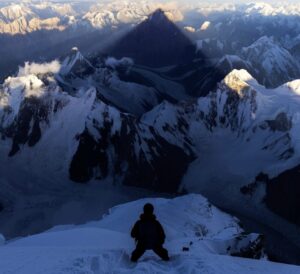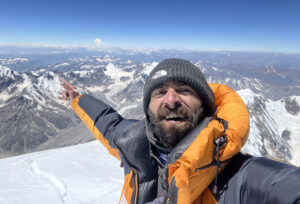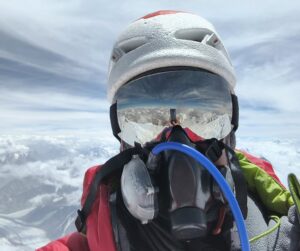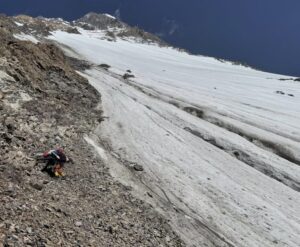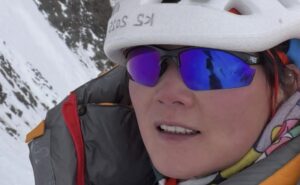Last week, Pakistani climbers brought the body of Muhammad Hassan down from 8,400m on K2. They took him back to his family, thus closing a shameful episode in both the climbing industry and the history of K2. But there is, at least, hope that this might be a turning point for future 8,000m expeditions in Pakistan.
As Hassan agonized at 8,200m on July 27, 2023, climbers who had jumped over him on their way to the summit and back tried to shield themselves from criticism behind the supposed impossibility of rescuing someone from such a place. One year later, five men extricated the body from a coffin of solid ice and managed to bring him down in 48 hours, efficiently, safely, and affordably. It’s proof that the most remarkable acts in the mountains may not involve a summit. The whole operation started with the will and logistical skills of a Pakistani woman, Naila Kiani.
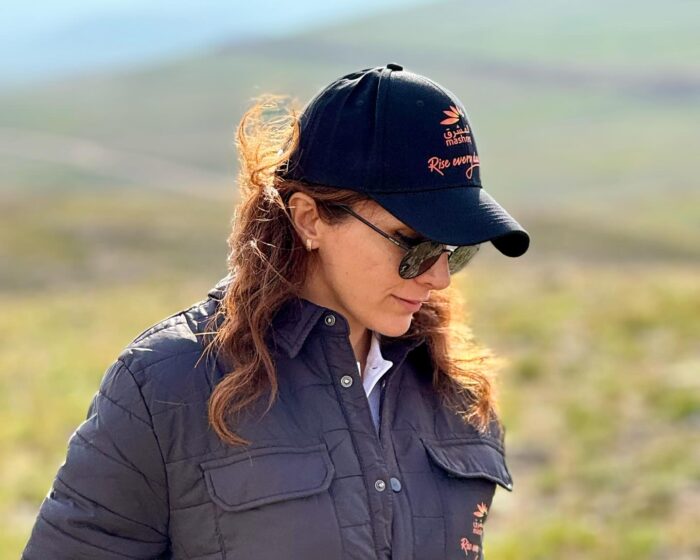
Pakistani climber and K2 clean-up project manager Naila Kiani. Photo: Naila Kiani
‘They were still crying’
Naila Kiani is pursuing her own 14×8,000m challenge, but she was on K2 this summer not to climb it — she had already done so last year — but to carry out a clean-up project, sponsored by Mashreq Bank.
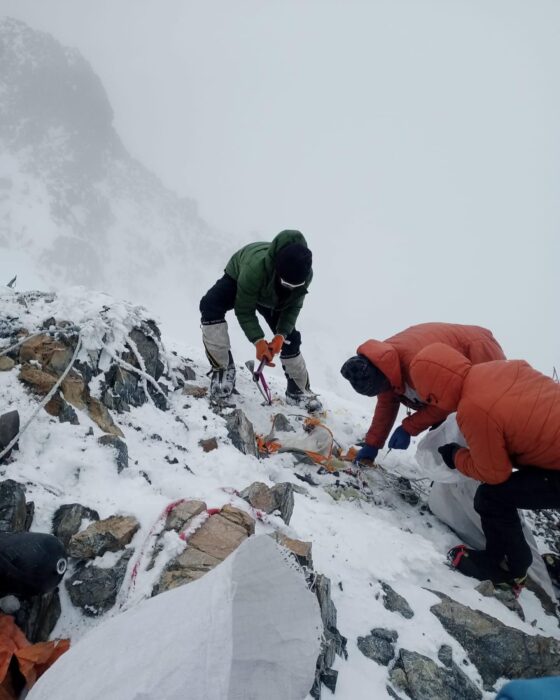
The clean-up team on K2. Photo: K2 Expedition Team
Kiani coordinated a combined team of low-altitude porters and climbers to improve the poor state of higher camps.
“During this time, I learned that Hassan’s family had been seeking assistance for over a year to retrieve his body and, aware of my team’s presence, were trying to contact us,” Kiani told ExplorersWeb. “I met Hassan’s mother, Khadija Bibi, and his wife, Batool Hassan in Skardu before the mission. They were still crying…They wanted to bury the body in their village to have closure.”

Wilhelm Steindl (left) visited Muhammad Hassan’s family after the tragedy on K2. He has helped Hassan’s family, invested in a climbing school project, and contributed to the recent recovery operation. Photo: Philip Flaemig
Muhammad Hassan was an inexperienced climber who joined the K2 summit push, hoping to increase his standing in the climbing community. He fell sick and suffered a slow death at the Bottleneck while around a hundred climbers passed him on their way to the summit.
As the line of climbers descended, they passed Hassan’s corpse. He left a sick mother, a widow, and four sons behind. His youngest child was born months after he died on K2.

Footage by Philip Flaemig shows a line of climbers under the Great Serac and K2’s Bottleneck, with Hassan’s location circled. Photo: Philip Flaemig/Servus TV
Hassan’s family has fared better than many families who have lost their main provider in Pakistan’s mountains. After ExplorersWeb broke the story, it quickly went viral, thanks to Philip Flaemig’s revealing drone footage and the testimony of Austrian climber Wilhelm Steindl.
Steindl raised a remarkable amount of money to support Hassan’s family. According to Kiani, Steindl saw that the family got a new house, land, and money in the children’s accounts until they turn 18.
The retrieval
Kiani’s team decided to try and retrieve the body. They received the necessary No Objection Certificate (NOC) from local authorities on July 18, just days before the summit window.
“Despite no initial funding and not enough [personnel or] time…I accepted this mission with my heart,” Kiani said. “Then I used my brain to find the most efficient way to make it happen.”

Naila Kiani at K2 Base Camp earlier this summer. Photo: Naila Kiani
The team included three climbers just back from Nanga Parbat: Akbar Sadpara, Dilawar Sadpara, and Zakir Sadpara. It also featured one climber from the clean-up team, Murad Sadpara, and another, Ali Mohammed, who had just returned from the summit.
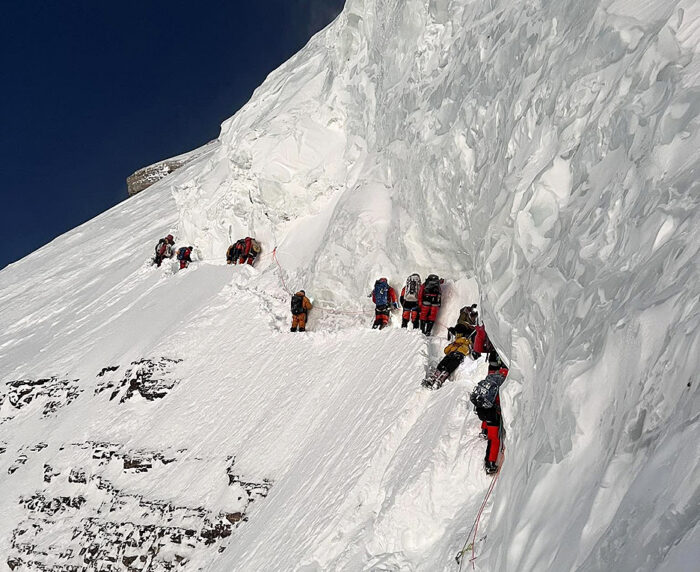
Climbers move around Hassan lying on the snow. Photo: Lakpa Sherpa
Minimizing costs
“My logistics partner, Imran Pakora, agreed not to make any profit [from the expedition] and kept costs low by using the existing clean-up team’s infrastructure at Base Camp,” Kiani said.
On July 27, Kiani sent the team to Camp 2 with instructions to wait there while she asked the K2 rope fixers to see if the body was still under the Great Serac. On July 28, they confirmed the body’s location.
The retrieval operation took place immediately. The team recovered the body and brought it to Camp 4 on July 30. One day later, they all returned to Advance Base Camp.
Not for free but not for profit
“I had tentative support from potential donors, including the Gilgit-Baltistan government and Wilhelm Steindl, but I aimed to secure funding internally,” Kiani noted.
This is important. The question of who foots a rescue bill is paramount since costs can be extraordinarily high. While it is usually kept quiet, those involved in rescues or body retrievals often turn a profit.
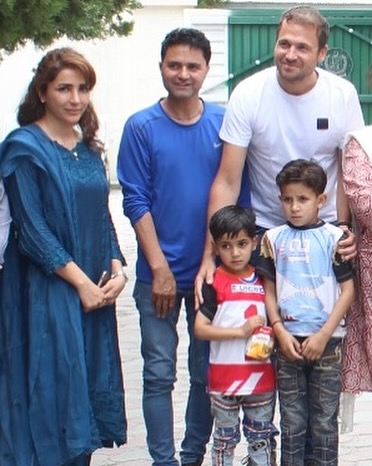
Naila Kiani, Imran Shigri of the logistics company, and Wilhelm Steindl with Hassan’s family. Photo: Naila Kiani
“This mission was humanitarian, but we aimed at covering the expedition costs, including the climbers’ salaries,” Kiani said. “The logistics company only charged for food, transport, and oxygen [at cost]. I also didn’t take any money. All the funding we received went directly to the logistics company. Eventually, I couldn’t find an internal sponsor, so I asked Steindl, who had supported the family a lot last year and is working on a mountaineering school project in Pakistan. He generously paid the logistics company.”
Confidence boost
The retrieval has brought comfort to a devastated family. It has also made a clear point: a rescue at 8,400m on K2 is possible. Often unfavorably compared to the Nepalese Sherpas, the Pakistani mountaineering community has demonstrated they are skilled, driven, and strong enough to perform something previously considered impossible.
“The recovery mission has given confidence to the climbers that they are capable of executing risky rescue missions,” Kiani said. “It should also give foreign climbers confidence in the capabilities of Pakistani high-altitude workers. I also hope that with this success, the relevant government organizations can help us establish structured rescue teams.”
Next steps: training, payment, certifications
What Pakistani climbers need now to take the next step forward are better conditions, complete training, and proper certifications.
“Many Pakistani high-altitude porters and climbers are highly skilled but lack international certification,” Kiani explained. “While some have great potential, they often receive minimal training and poor compensation. Inadequate pay and poor treatment results in lower performance, leading to a loss of faith among Western climbers.”
She notes that Pakistan doesn’t have any IFMGA-certified guides, while Nepal has over 90. “In Western countries, guides taking clients to high altitudes must be certified, but Pakistan doesn’t have that requirement yet,” she says.
Some private initiatives, such as Steindl’s, aim to provide mountaineering training. But Kiani is aiming for more. She has managed to get support from Pakistan’s Prime Minister Shehbaz Sharif to create a state-of-the-art climbing school to certify climbers at an international level.
“We want to make sure that all high altitude workers and climbers get certified training, so they can also get appropriate salaries and provide a high quality of service to international clients.”
According to Kiani, Nepali Sherpa guides earn an average of $10,000 for guiding a client, while Pakistani high-altitude workers average $2,000 for equivalent work.
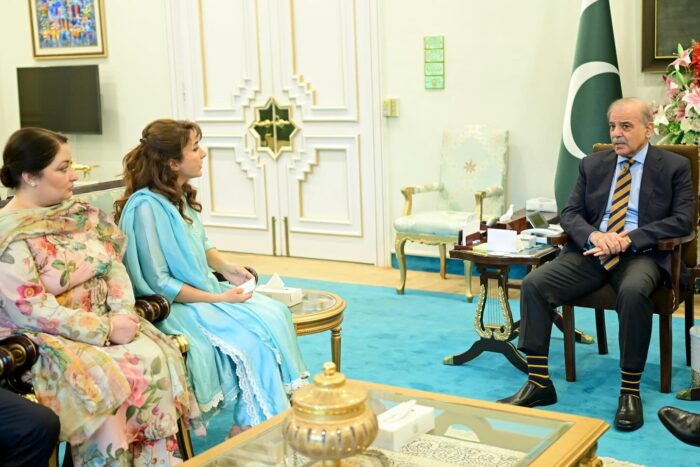
Naila Kiani (in blue) and Pakistan Prime Minister Shehbaz Sharif. Photo: Naila Kiani
A silver lining
The project started last month.
“We have sent a report to the Prime Minister and are waiting for budget approval,” Kiani told us. She is also seeking support from the international climbing community.
“In the initial years, we’ll need help to train instructors in Pakistan, develop a curriculum, and improve mountain tourism infrastructure,” she said.
Hassan’s death shocked many readers, embarrassed the climbing community, and prompted an investigation by Pakistani authorities. Yet the real turning point could be this recovery mission. It has shown that something can be done for climbers in trouble high on K2. More importantly, it looks set to spark a national project to improve the lives of local climbers so that tragedies such as Muhammad Hassan’s won’t happen again.

Muhammad Hassan. Photo: Alpine Adventure Guides

